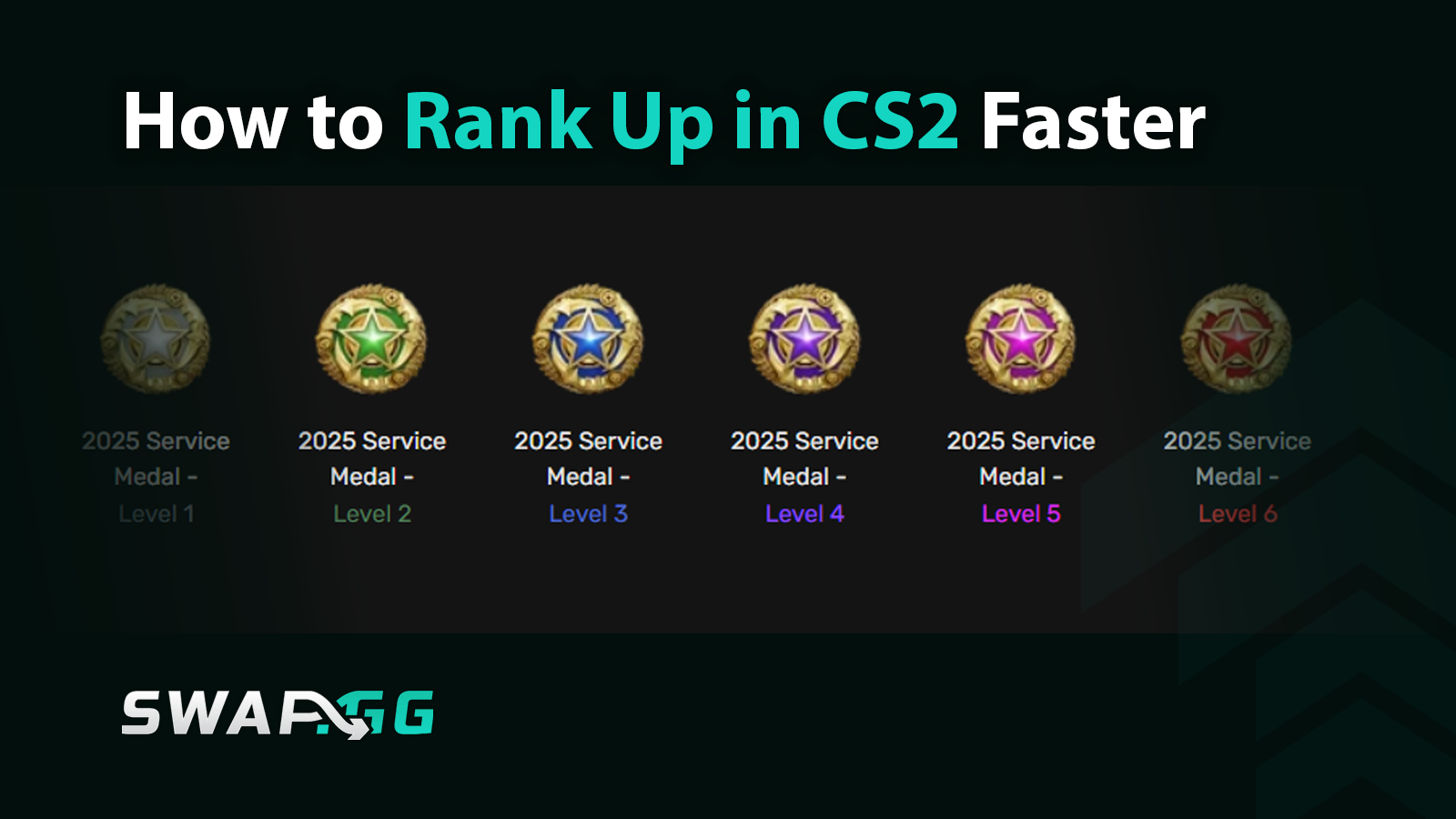How to Rank Up in CS2 Faster: Economy, Utility & Meta Secrets

Publié le dans CS2

The truth is that ranking up in CS2 is purely a game of grinding, learning skills, making better decisions, and enhancing muscle memory. You cannot get these skills overnight, but there are a number of tricks that you can resort to in order to become better at CS2 and rank up more quickly. In this article, we will cut through all the clutter and explain how you can rank up in CS2 faster in our guide, so read on to find out more.
Understanding CS2's Ranking Ecosystem
In CS2, rank is determined by combining your level of impact and consistency. The game has a very detailed rating system that will keep track of your record on each map across the board. That will be reflected in seeing individual ratings by each map, so that you will be able to work on improvement in different areas. Your rank goes up or down based on how you do against your teammates (based on kills, assists, deaths, MVPs, matches/games you win, and your personal success compared to your enemies and not your team), but it is not solely based on how many times your team wins overall.
The ranks themselves exist as a set of tiers, identical to CS:GO, but with new graphics and terminology specific to CS2. With this system, you will have a better understanding of where you are placed with respect to the skills you possess and develop over time. Competitive Mode The first thing you need to do is finish a series of placement matches (typically 10) to determine your initial rank.
You are not punished by taking a break, and your rank stays visible until you set it. The structure will also minimize stress and make players concentrate on gradual advancement. The MR12 format (first to 13 rounds) is used; this means that each round counts towards the match. A single clutch play or better calculation will shift the balance of a game, and every single moment is thrilling and meaningful.
Master the Fundamentals
Optimize Your Game Settings
Making tiny adjustments to your game configuration can make massive differences in your game. Make sure that you adjust the sensitivity of the mouse to achieve an element of finesse of movement through precision. Put the graphics down to increase frame rates, making you gain a smooth gameplay experience and quicker reflexes. Never dismiss the importance of decent sound settings, whether it is a decent headset and ample volume levels to hear gentle footsteps and the grenade alerts that can save your life. Experiment with these settings a bit, and you will come across something that feels natural and consistent. There are tons of pro players who post their settings online and that can be a great place to start.
Aim and Recoil Control
The best way to improve your shooting is by using aim trainers, such as Aim Lab or Kovaak. Train to flick shots, track fast-paced targets, and get an understanding of the spray patterns of weapons such as the AK47 and M4A4. As an example, M4A4 needs to have a drift in recoil, up-left, so aim to keep pulling down and right when you are firing in bursts. A regular training will ensure that you have developed a muscle memory that will turn your frantic firefighting moments into rationalised firefights.
Although Aim Lab and Kovaak are amazing practice tools, don’t overlook in-game community maps such as Aim Botz and Recoil Master. These maps allow you to train your spray patterns, flick shots and tracking within the real environment of CS2, helping you better transfer your skills into play in competitive matches. Combining outside aim training and game practice builds functional training sessions.
Movement Mechanics
Movement is not merely running and shooting, it is the management of your own location and the generation of sound. Strafing, crouch-walking, and smart peeking allow you to be unpredictable and precise. But be careful when jumping in the middle of a running because it can be used to evade or avoid being hit by the enemy fire during some circumstances, but jumping lowers your accuracy a great deal, so only when necessary and when there are no other means available avail. The ability to move around silently and when to be more forceful with your movements can go a long way in times of clutch moments.
Crosshair Placement
You should constantly keep your crosshair at head height in health risk regions, mid-map choke points, and bombsite engagements as well as in typical combat regions. When an enemy appears, you would have a split-second advantage by dropping it into the habit of being fired in an instant.
Map Mastery: Control the Battlefield
Callout Fluency
Memorize map-specific callouts (e.g., “Window” on Mirage or “Mid Doors” on Dust II) to communicate efficiently with teammates. Clear callouts facilitate faster rotations and coordinated pushes. For example, shouting “Lurker top mid!” alerts your team to a hidden enemy, preventing costly surprises.
Auditory Awareness
Invest in a good headset to understand audio feedback. The sounds of footsteps on the wooden floors, the bounces of a grenade, and reloading noises divulge the position of the enemy. In case you hear the sound of another teammate's weapon firing, change your position to evade cross-firing.
Positioning Tactics
Avoid predictable spots like open windows or narrow corridors. Instead, use a cover to peek safely. For example, on Inferno’s bombsite B, crouch behind the wall to bait enemies into overextending before flanking.
Teamplay Over Lone Wolf Mentality
Communication Hierarchy
Pass important information like the location of enemies, and the availability of utilities (e.g. “Flash charging”), but avoid overloading chat with unnecessary pings. Tactical role coordination (entry fragger, support, lurker) is done within elite prestigious teams like Team Liquid to maximize synergy.
Utility Synergy
In order to effectively push up the ladder, one has to learn particular grenade set-ups for popular maps. As an example, a smoke well-placed around the mid-connector of Mirage can destroy the vision of the enemy and create an opportunity to push through with your team. It takes time to learn these lineups; however, the payoff is the tactical advantages you can give your team to win rounds. You can watch tutorials or practice throwing grenades in offline gaming to accumulate a solid utility arsenal.
Role Adaptation
Games are won by flexibility, so when your team is short on an entry-level player, take the aggressive position. On the other hand, you can assume the lurker role in the event of being outgunned and collect information about enemies and ambush them one by one.
Tactical Decision-Making
Economy Management
It is a fine line between being economical with your team. Learning how to save (“eco rounds”) or force-buy can leave your squad with enough equipment to start a fight. The middle ground that can be used sometimes is the partial buy, buying the armor and pistols, rather than the rifles. Talk to your teammates about who buys what, and you will not have a disassembled armory. Monitoring of the enemy economy will also enable you to know what the enemy is likely to buy, and plan in that way.
Adaptive Strategy
If your initial plan fails, be ready to rotate positions mid-game. On maps like Vertigo, if bombsite A is well-fortified, pivot to bombsite B with a decoy grenade to confuse defenders. Predictable strategies are easy to counter.
Clutch Tactics
When on 1vX, play survival, not fancy. Exploit the environment, place the bomb to lure the enemies close, and then pick them off at a time. Baiting out of a hiding place can be done with fake defuses.
Mental & Strategic Mindset
Patience Over Aggression
Avoid rushing into fights without backup. Gather intel by rotating slowly or using decoys. For example, on Anubis’ bombsite C, wait for teammates to clear mid before committing.
Post-Match Analysis
Review demos to dissect mistakes. Did you peek mid without a smoke? Did you waste a flash on a non-threat? Use these insights to refine your approach.
Mindset Resilience
Tilt is your worst enemy. After a bad loss, reset your focus by hydrating, stretching, or taking a short break. Successful players treat setbacks as learning opportunities.
Conclusion
Progressing in CS2 involves a balance of mechanical ability and strategies, together with teamwork. Understanding the basics of aiming, movement, and control maps through good communication and adjustment of strategies during the game will always enable you to defeat your enemies. Understand that things do not go straight; take failure as a chance to develop. Remain patient, evaluate your errors and devote yourself to step-by-step progress. It may sound far-fetched, but with commitment, that badge of Global Elite is not only a dream but a matter of inevitability.
Publié le dans CS2
![[THUMBNAIL] Is 7.1 Surround Good for CS2? The Reality Behind Virtual Audio](https://swap.gg/cdn-cgi/image/f=auto/https://blog.swap.gg/content/images/2025/12/Is-7.1-Surround-Good-for-CS2_.png)
![[THUMBNAIL] Is CS2 CPU or GPU-intensive? What Hardware Actually Matters](https://swap.gg/cdn-cgi/image/f=auto/https://blog.swap.gg/content/images/2025/12/Is-CS2-CPU-or-GPU-intensive_.png)
![[THUMBNAIL] What Is the Cheapest Knife in CS2? Your Complete Budget Guide](https://swap.gg/cdn-cgi/image/f=auto/https://blog.swap.gg/content/images/2025/12/cheapest-knives.png)